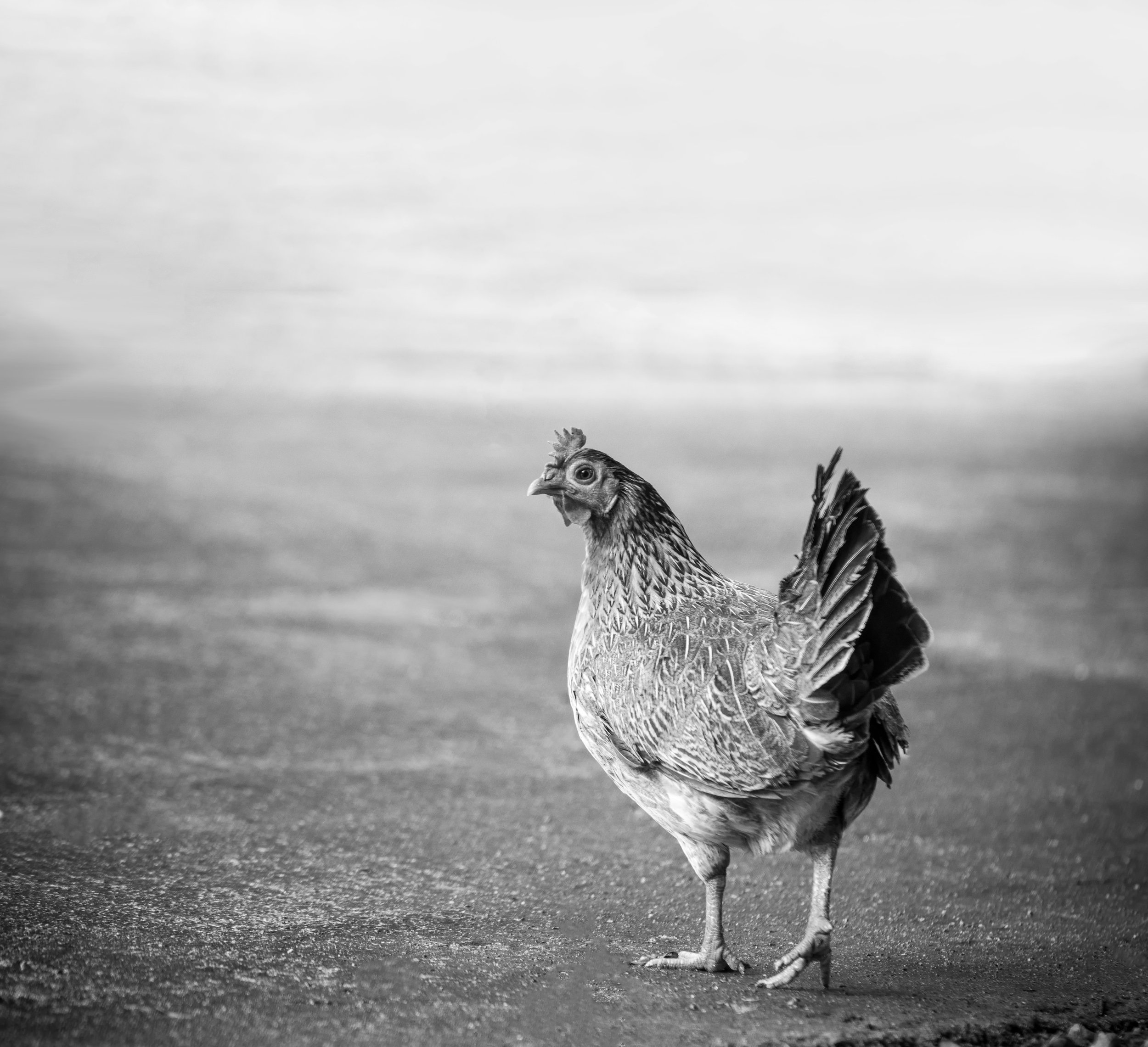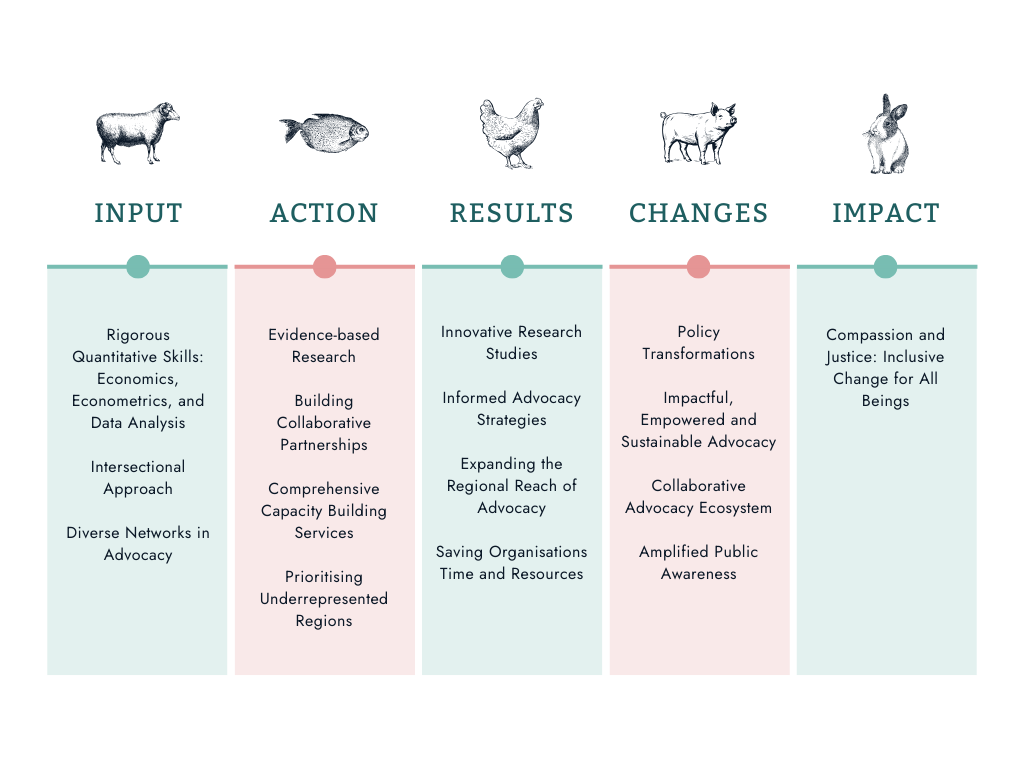
Meet Animetrics
What do we do?
At Animetrics, our work is threefold:
Original Animetrics Studies:
We conduct original research to explore the animal advocacy landscape and to address crucial research questions that are vital to advancing the movement. Our aim is to provide actionable recommendations for advocacy efforts based on the insights gained from these studies.
1
Collaborative Research:
We engage in collaborative research with fellow organizations. We believe that sharing our expertise and engaging in multidisciplinary work leads to mutual growth, increased research quality, broader reach, and eventually higher impact for the movement.
2
Capacity-Building Services:
We actively engage in capacity-building initiatives to support fellow organizations and activists in their quantitative research and evidence-based advocacy efforts. These initiatives aim to empower animal protection organizations and decision-makers, enhancing their capabilities and skills. Our capacity-building services include proposal development, report enhancement, data analysis, survey design, ensuring ethical compliance, impact evaluation, education and training, and consultancy acquisition.
3
See here for more detailed information on collaboration opportunities and the services we provide.
We offer all our services without any charge, thereby saving valuable resources for fellow organizations. Join us in our commitment to creating a better future for all beings.
Why do we do what we do?
Why do we advocate for the rights of animals?*
*For brevity and reader-friendliness, we refer to "non-human animals" as "animals" on this website.
Animetrics advocates for the rights of animals. From an ethical standpoint, animals are not commodities but sentient beings, capable of feeling and experiencing suffering. They possess intrinsic value and are entitled to ethical consideration. For us, treating animals with respect and compassion is a non-negotiable moral imperative. (1)
Our commitment to animal rights also aligns with our broader understanding of social justice. Animal injustice is closely linked to other forms of oppression, including social, environmental, and economic inequalities. (2) For instance, workers in slaughterhouses, often from marginalized backgrounds, endure poor pay, extended working hours, and unsafe conditions. Similarly, employees in tanneries are often at increased risk of cancer, and forced labor and human trafficking are common in the fisheries industry. Factory farming also disproportionately impacts marginalized communities, often placing low-income populations, many of whom are people of color, in close proximity to the harmful environmental effects of these industries, such as air and water pollution. This environmental injustice further deepens disparities in health and well-being, exacerbating poverty and social inequities. (3)
Furthermore, the exploitation of animals significantly contributes to environmental degradation, intensifying climate change, destroying ecosystems, depleting vital resources, and causing habitat destruction. (4) It also poses risks to human and animal welfare through the spread of zoonotic diseases. (5)
The urgency of animal justice arises from our ethical duty to recognize animals' inherent worth and the undeniable interdependence of our well-being with theirs. Creating a world characterized by compassion, equity, and justice demands addressing animal, environmental, and social injustices simultaneously.
Why is our expertise in economics and econometrics important for effective animal advocacy?
To maximize our impact in animal advocacy, making well-informed and evidence based decisions is critical.
Our background in economics and econometrics enables us to make informed decisions based on data, efficiently allocate the limited resources, and measure impact accurately.
Additionally, our expertise empowers us to utilize causal inference techniques. Understanding causality is important because it allows us to identify the true impact of advocacy interventions, differentiating between causation and correlation. For example, we need to understand whether offering more vegan options at restaurants is actually causing more people to choose these meals, or if people are already shifting towards plant-based eating due to a trend. These methods are vital for assessing advocacy effectiveness, evaluating the impact of various interventions, and understanding attitudes towards animal welfare.
In addition, we can analyze the economic impacts of various animal advocacy initiatives. This includes the costs and benefits of different approaches, evaluating the financial viability of alternative practices, and understanding economic incentives driving certain behaviors related to animal use. Using advanced statistical and quantitative methodologies, we can pinpoint key factors driving success.
Overall, our expertise in economics and econometrics equips and complements advocacy organizations with essential tools to address urgent challenges effectively and gain support from policymakers, donors, and the public.
Why do we adopt an intersectional approach?
Adopting an intersectional approach is crucial for us because it strengthens and broadens the reach of animal advocacy. The intersections of race, class, gender, and more not only overlap with advocacy issues but also highlight the shared struggles and lessons between social justice movements. By working together and facilitating collaboration, we can develop comprehensive strategies that tackle both the rights of animals and broader social and environmental justice challenges.
A united voice can lead to more significant policy changes, shifts in societal thinking, and increased awareness. Furthermore, this approach helps us challenge stereotypes, gain credibility, and focus on long-lasting changes by addressing the root causes. In essence, our intersectional stance enables us to advocate more effectively and comprehensively.
Why do we have a specific regional prioritization?
While our work extends globally, we prioritize addressing neglected areas in the animal protection movement, particularly in the Global South. These regions are home to a significant number of animals being farmed, yet they receive relatively little attention in terms of research and funding. Recognizing this gap, we believe that additional research in these areas holds great potential for making a meaningful impact. By focusing on and supporting these regions at no cost, we aim to bridge this gap and effect substantial change.
Moreover, we recognize the importance of diversity and inclusivity in effective advocacy. Regions that are traditionally underrepresented in animal advocacy bring their own set of challenges but also offer unexplored potential and fresh perspectives. (6) Focusing on them allows us to develop strategies that are culturally and contextually relevant, resonating with local communities. By targeting our efforts where they are most needed, we contribute to a richer, more comprehensive global dialogue on animal advocacy.
-
See: Regan, T. (2013). ‘The Case for Animal Rights.' In Ethics, Humans and Other Animals (pp. 179-188). Routledge.
Singer, P. (2004). Animal liberation. In Ethics: Contemporary Readingsi> (pp. 284-292). Routledge.
-
See: Adams, C. J. (2018). The sexual politics of meat. In Living with Contradictionsi> (pp. 548-557). Routledge. Harper, A. B. (Ed.). (2009).
Sistah vegan: Black female vegans speak on food, identity, health, and society. Lantern Book
-
Matsuoka, A., & Sorenson, J. (2013). Human consequences of animal exploitation: Needs for redefining social welfare. J. Soc. & Soc. Welfare,i> 40, 7. Hribar, C. (2010). Understanding concentrated animal feeding operations and their impact on communities.
Bernstein, J., & Dutkiewicz, J. (2021). A public health ethics case for mitigating zoonotic disease risk in food production. Food ethics,i> 6(2), 9.
McDonald, G. G., Costello, C., Bone, J., Cabral, R. B., Farabee, V., Hochberg, T., ... & Zahn, O. (2021). Satellites can reveal global extent of forced labor in the world’s fishing fleet. Proceedings of the National Academy of Sciences, 118(3), e2016238117.
Walk Free Foundation. (n.d.). Forced labour at sea. Global Slavery Index. Retrieved from https://www.walkfree.org/global-slavery-index/findings/spotlights/forced-labour-at-sea/
Slade, J., & Alleyne, E. (2023). The Psychological Impact of Slaughterhouse Employment: A Systematic Literature Review. Trauma, Violence, & Abuse, 24(2), 429-440. https://doi.org/10.1177/15248380211030243
Human Rights Watch. (2012). The Health Repercussions of Bangladesh’s Hazaribagh Leather. Retrieved from https://www.hrw.org/reports/bangladesh1012_brochure_web_0.pdf
-
Scarborough, P., Appleby, P. N., Mizdrak, A., Briggs, A. D., Travis, R. C., Bradbury, K. E., & Key, T. J. (2014). Dietary greenhouse gas emissions of meat-eaters, fish-eaters, vegetarians and vegans in the UK. Climatic change, 125(2), 179-192.
Barreto, P., Souza Jr, C., Noguerón, R., Anderson, A., & Salomão, R. (2006). Human pressure on the Brazilian Amazon forests. World Resources Institute, Washington, DC.i>
World Wildlife Fund (October, 2017) Appetite for Destruction. Retrieved from https://wwfint.awsassets.panda.org/downloads/wwf_appetitefordestruction_full_report_web_0_1.pdf
-
Manyi-Loh, C., Mamphweli, S., Meyer, E., & Okoh, A. (2018). Antibiotic use in agriculture and its consequential resistance in environmental sources: potential public health implications. Molecules,i> 23(4), 795.
Otte, J., & Pica-Ciamarra, U. (2021). Emerging infectious zoonotic diseases: The neglected role of food animals. One Health, 13, 100323.
-
Farmed Animal Funders. (2021). State of the movement Report: 2021. Global Trends in philanthropy fighting factory farming. https://farmedanimalfunders.org/wp-content/uploads/2021/12/External-FAF-State-of-the-Movement-Report-2021.pdf
Our Theory of Change
Animetrics stands out with its expertise in economics, econometrics, and causal inference methodologies. This expertise enables us to accurately assess the impact of advocacy interventions, weigh the costs and benefits of different approaches, evaluate the financial viability of alternative practices, and understand the economic incentives influencing behaviors related to animal use.
Our approach is simple yet powerful: through evidence-based research and collaborative partnerships, we pioneer innovative studies that drive progress. These studies play key roles in raising public awareness and influencing policy changes.
Additionally, our capacity-building initiatives aim to empower fellow organizations. By offering research support services, we enable these groups to advance their advocacy goals with greater autonomy and efficiency.
Through our commitment to prioritizing neglected regions and embracing an intersectional approach, we expand the reach and geographic scope of advocacy efforts.
By providing all our services free of charge, we save organizations valuable time and resources.
These outcomes collectively increase the effectiveness and the regional reach of the advocacy. As advocacy efforts become more evidence-based, a greater number of animals will be treated with compassion and respect.
We recognize that our impact is often indirect, manifesting through the successes and advancements of the organizations, advocates, and broader communities we support. To ensure we're making the desired difference and to continuously refine our approach, we employ a combination of quantitative and qualitative metrics to comprehensively assess our reach and influence.
Quantitative Measures: Citation rates, report reach, website visits, and social media engagement.
Qualitative Measures: Feedback from collaborating organizations, both through our research initiatives and capacity-building services.

Our Story
Our journey begins at Boğaziçi University, our shared alma mater in Türkiye. Later on, life brought us together abroad. In the Netherlands, we were both in the Economics Ph.D. program at Tilburg University. Beyond being fellow scholars, we also became housemates. In the intimacy of shared living, our friendship deepened, and our shared values found fertile ground.
Initially bound by a strong feminist solidarity, our journey took a deeper turn when we both embraced a vegan lifestyle, driven by ethical and environmental considerations. This transformation marked the intersection of our values with a broader commitment to non-human animal rights, sparking discussions on how best to contribute to the movement.
This intersection is no mere coincidence; it's the recognition of the common thread running through both movements - the desire for a world built on justice, compassion, and equality. In our transition, we realized that the same values of fairness, respect, and solidarity that drive our feminist beliefs resonate deeply in the fight for non-human animal rights.
Our academic paths and dedication converged when we worked with Vegan Hacktivists to understand data and technology within the animal rights movement. This experience allowed us to witness the strength of collective effort.
Drawing from our experience and passion, we identified a pressing need for rigorous quantitative analysis in animal advocacy, particularly through the perspective of economics & econometrics. We also recognized the potential of fostering collaboration across diverse advocacy movements, offering essential capacity-building services, and prioritizing underrepresented regions in the movement. With our academic backgrounds in economics, we felt uniquely positioned to infuse this domain with a fresh perspective. This realization laid the foundation for Animetrics: animals and econometrics.
Animetrics embodies our shared values and our commitment to animal rights. It's more than just an organization; it's our feminist solidarity and our commitment to a more compassionate and just world. With fairness, unity, cooperation, and respect at its core, Animetrics strives to create a world where kindness knows no boundaries.

